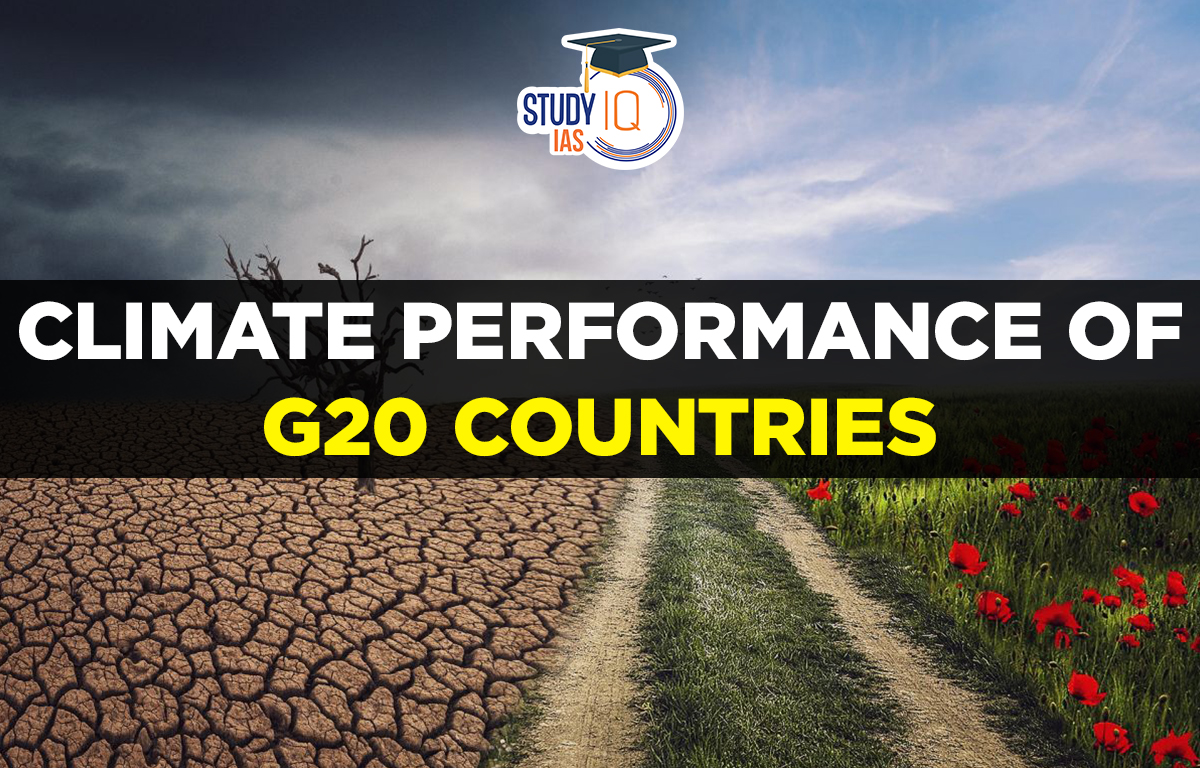Table of Contents
Context: India, with a Climate Performance Index score of 0.76, has been classified as a leader among the G20 nations striving to mitigate climate change, according a study published by the Observer Research Foundation (ORF).
Introduction
- Multilateral forums like the Group of Twenty (G20) play a crucial role in bolstering global collective action against climate change.
- Significance of G20 towards climate change mitigation:
- The G20 economies are responsible for about 75 to 80 percent of global greenhouse gas emissions.
- All but one of the top 10 carbon-emitting countries are G20 members.
- The G20 economies, which hold the majority of global wealth, have the financial resources to lead the necessary green transition for limiting the global temperature increase to 1.5°C.
- Moreover, the G20 countries are home to many of the world’s most significant carbon sinks, such as the Brazilian Amazon Rainforest, the Steart Marshes in the United Kingdom (UK), and the Sundarbans in India.
What is the G20?
- The G20 was formed in 1999 in the backdrop of the financial crisis of the late 1990s that hit East Asia and Southeast Asia in particular.
- It aims to secure global financial stability by involving middle-income countries.
- Together, the G20 countries include 60% of the world’s population, 80% of global GDP, and 75% of global trade.
Key Highlights of the Study
- Study methodology: The study has used the Climate Performance Index (CPI) to evaluate the performance of the G20 countries in climate change mitigation.
- About CPI: CPI is an independent monitoring tool for tracking the climate protection performance of 59 countries and the EU.
- Publisher: CPI is published by Germanwatch, the New Climate Institute and the Climate Action Network annually since 2005.
- Index Composition: CPI assesses climate protection performance based on four categories:
- Greenhouse Gas Emissions (40 percent of the overall score),
- Renewable Energy (20 percent),
- Energy Use (20 percent),
- Climate Policy (20 percent).
- Climate performance of the G20 countries:
| Leaders in Climate Performance |
|
| Emerging economies |
|
| Advanced economies |
|
Key Recommendations suggested by the study (In the context of India’s G20 presidency)
- Mainstreaming carbon budgeting into global climate action: Developed countries have used a large portion of the carbon budget, and it is crucial for the remaining budget to be fairly allocated to developing countries to achieve equitable and just climate action, which India’s G20 presidency can work towards.
- Sustainable consumption for climate change mitigation: Achieving sustainable consumption is crucial for climate change mitigation, and India’s G20 presidency can be used to garner support for the Mission LiFE initiative to promote climate-friendly behavioural changes and achieve SDG 12.
- Adoption of climate action that is sensitive to carbon inequality: Income and wealth inequalities result in carbon inequality. Hence, Climate policies should not be defined in isolation from poverty alleviation programmes.
- Protecting the climate-regulating land cover of the world: India’s successful preservation of climate-regulating land cover can be used as a model for a G20 action plan on preserving such land cover for climate action.
- Enabling a transition to green growth: To enable a transition to green growth, developed countries should experience absolute decoupling while developing countries should experience relative decoupling.
- Here “decoupling” refers to the ability of a country to separate its economic growth from its carbon emissions.
- Prioritising expansion of renewable energy capacities: Both the developed and developing economies of the G20 need to increase the proportion of renewable energy capacities. This can be an important focus area of India’s G20 presidency.
- Coordination between national and sub-national governments in climate action: Successful climate action will require taking into account local realities into climate mitigation strategies. India’s G20 presidency can develop a template of and articulate fundamental principles for this coordination.


 Daily Quiz 11 July 2025
Daily Quiz 11 July 2025
 Operation Baam: Baloch Separatist Group ...
Operation Baam: Baloch Separatist Group ...
 Article 326 and Electoral Roll Revision ...
Article 326 and Electoral Roll Revision ...





















